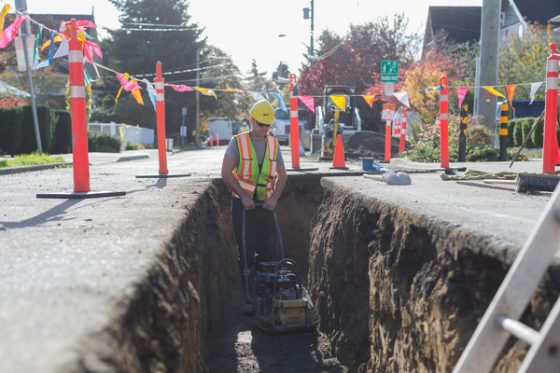Freshen up your knowledge on traffic safety to help keep roadside workers safe while they do their jobs in the cone zone.

Photo credit: © WorkSafeBC (Workers’ Compensation
Board of B.C.), used with permission
Mitchell Martin is a dad, husband, and soccer coach. He’s also a tow truck driver who provides crucial help for stranded drivers.
Mitchell is one of more than 10,000 people who work on B.C. roadsides — along with traffic control persons, road-maintenance crews, first responders, municipal workers, construction crews, and many others.
“There are times, for sure, that I’ve been scared on the road,” Mitchell says in this video from the Work Zone Safety Alliance. “Vehicles are travelling way too fast, speeding by with no concern whatsoever.”
Statistics from conezonebc.com put the uneasiness that Mitchell conveys into perspective. Last year, in 2019, one roadside worker died after being hit by a motor vehicle and 19 were injured resulting in time-loss. Between 2010 and 2019, 13 roadside workers died and 204 were injured resulting in time-loss.
Drivers’ role in workplace safety for roadside workers
I drove past some roadside workers today as I was thinking about this blog post. One of the workers was placing cones on the road, and I thought about the idea that “Every cone stands for a person working behind it.” This is one of the messages from the annual Cone Zone campaign, now in its 10th year. The Fraser Coast Integrated Road Safety Unit (which includes RCMP as well as municipal police officers) is partnering with the Work Zone Safety Alliance and WorkSafeBC to raise awareness of risks faced by roadside workers.
Drivers must slow down and pay attention to instructions from traffic control persons, temporary road signs, and traffic control devices. Employers have a legal responsibility to ensure the health and safety of their workers and contractors along B.C.’s roads and highways, including:
- Ensuring their workers understand the hazards related to working at the roadside.
- Providing their workers with training, equipment, supervision and resources to help keep them safe.
Slow down, move over
Drivers are also required to follow the “slow down, move over” law when they see red, blue, or amber lights flashing on the highway. (For more information on this B.C. law, in place since 2015, see my post New laws to protect roadside workers.)
This means that if the speed limit is 80 km/h or more, you must drop your speed to 70 km/h or slower and pull over into an open lane to leave space for the roadside person to work. If the speed limit is less than 80 km/h, you must drop to 40 km/h or slower and move over.
Read more about reducing the risk of roadside work in the July/August 2020 issue of WorkSafe Magazine. Also see Working in and around traffic for more resources from WorkSafeBC.
If you are a roadside worker — or you have a loved one who is — maybe you have your own message for drivers. Please share your message in the comments below.


